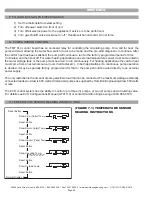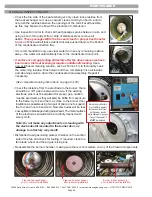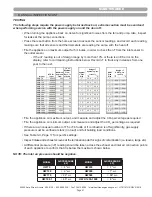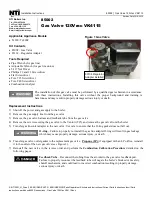
34000 Autry Street, Livonia, MI 48150 | 800.968.5530 | Fax 734.419.0209 | www.hamiltonengineering.com | LIT91127US REV 5/2018
Page 44
67.
Venting system has too much resistance (possibly partially blocked)
68.
Pressure switch is defective
71.
Wiring to sensor is disconnected or incorrectly connected
72.
Insufficient flow through the boiler
73.
Heat exchanger is beginning to accumulate scale
74.
Heat exchanger back wall high limit is open
75.
Burner door high limit is open, reset high limit
(TABLE 7-5) FAULT CAUSES (CONTINUED)
The numbers given in Tables 7-3 and 7-4 match with those in the following table to troubleshoot.
(TABLE 7-6) TROUBLESHOOTING THE FAULT
1.
Check room thermostat connections
4.
Try to loosen the pump spindle, replace the pump drive, or clean impeller
5.
Check available city water pressure—water heater must be over 15 PSI. Boiler closed loop
heater system must have at least 12 PSI from fill valve. Check operation of expansion tank.
7.
Remove and reconnect the wiring harness, being sure that the plus lines up properly and latches
when fully inserted
8.
Clean the fan blades
9.
Replace the fan -
see notes below under 13
10.
Open gas valve
11.
Check line, gas meter, and pressure to heater inlet (it must be at least 4 inches WC). Make a
pressure drop test and calculation, as required.
12.
Change gas lines. If a flexible connector is used, it must be rated for the BTU capacity of the appliance.
CONNECTORS PURCHASED AT HOME CENTERS WILL NOT WORK!
13.
Replace fuse. Check the pump.
16.
See pages 14-15
18.
Check cable and cap for shorting to ground, overheating, and cut or worn cable casing. Check
spark ignitor porcelain for cracks. Check for 1/8" gap at the tips.
21.
Check pump wiring and correct
22.
Open the condensate trap clean out (underneath the appliance in the center) by unscrewing
the cap. Keep a jug on hand to catch the water drained. Look through the drained material for
contaminants. If there are alot, remove the burner unit from the appliance, and pour some water
in the heat exchanger to rinse out the drain line (see Part 8, Section C). Eliminate water traps in
the drain hose.
23.
Bleed all air from not only the appliance itself, but the entire system. If working on a closed loop
heating system, take care not to run the pumps if there is no water; establish an uninterrupted
water flow.
25.
Check the inlet air and flue lines for blockage, inspect non-return damper.
26.
Check the inlet and flue system starting at the appliance outlet, confirm venting terminations
28.
Check all shut off valves and check valves. Be sure they are fully open.
SERVICING
















































